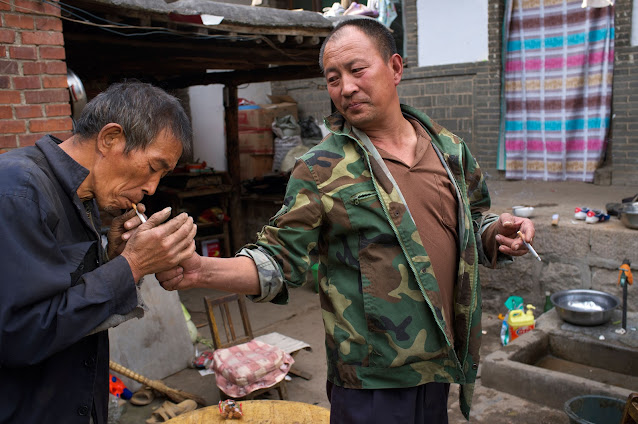Heat and humidity did a number on the flue-cured tobacco grown at the Tobacco Research Station in Oxford, N.C., this year, says Carl Watson, the station’s ag research manager. Watson (foreground) brought leaf to Raleigh for the the N.C. State Fair Tobacco Looping Contest on October 15 . It looked a little ragged. “The ends of the tip leaves were hard to get ripe and were difficult to sell,” says Watson. As one observer noted, the flue-cured had in effect gotten “cooked in the field.” But the yield wasn’t affected, at least not at the station, and a yield of as much as 3,000 pounds per acre may be obtained. The station is located about 40 miles north of Raleigh. Photo by Christopher Bickers.
FLUE-CURED
NORTH CAROLINA—There was a little flue-cured left at the end of last week, almost all of it in the western Piedmont of western N.C. While it was not a large amount, for some growers it could be the difference between profit and loss for this season. The growers will have a much better chance of success if frost will hold off for about seven more days, says Matthew Vann, N.C. Extension tobacco specialist. Maybe it will: There’s been no frost at all in North Carolina so far. “To date, we seem to have dodged that bullet,” he says. Vann had earlier estimated that the statewide average yield would fall in the range of 2,000 to 2,100 pounds per acre. “I see no reason to change it,” he says. USDA’s projection of 120,000 harvested acres still seems credible, so flue-cured production for the state might total 240,000 pounds, about what USDA projected in September and much more than was produced in 2020. Late in the season, there has been tremendous yield loss in the east, and some yield has been lost in the Piedmont because of drought. But the overall all yield will still be better than last year.
VIRGINIA—Flue-cured here still lagged somewhat behind schedule, and it was thought that it might take into early November to get this type harvested. The problem was too much rain combined with windstorms that blew over plants. Much of the crop had to be stood back up once, and some twice…To make matters worse, this has been an expensive crop to produce: Among many other things, farmers had to find additional labor, and fuel cost a lot…The crop was better in the eastern part of the tobacco area—Mecklenburg, Lunenburg and Dinwiddie counties—than in the west—Pittsylvania and Halifax counties, says one source. “We could still have a good crop but we need the frost to hold off,” he says…One odd note: There was a drastic difference in the distribution of rainfall during the season. “Some farms got 24 to 30 inches, while others got less than four,” the source says.
SOUTH CAROLINA, GEORGIA AND FLORIDA have completed harvest.
BURLEY
KENTUCKY--There might be a little burley left in Kentucky that has yet to be harvested but the vast majority of the state’s crop has been cut and barned, says Bob Pearce, Kentucky Extension tobacco specialist. “There are always a few stragglers.” Pearce expects the yields will be average and the color good. “I anticipate a quality burley crop.” But he hasn’t seen any stripped tobacco from this crop. The curing season has gone pretty well. “There were a couple of periods of wet weather that led to a touch of mold on some early cut tobacco, particularly on Connecticut broadleaf.” Other than that, the curing season has been mostly favorable. No killing frost yet: “A few areas experienced a very light frost on the 17th,” says Pearce. “I saw some on a few roof tops but did not see any on the ground. There was no impact on plants still growing at that time.”
TENNESSEE--In the east, heavy rain slowed harvest last week. As of Oct. 17 , the USDA estimated that a small portion of the tobacco crops still needs to be harvest-ed, perhaps four percent. It may in fact be completely harvested by now.
NORTH CAROLINA--Burley growers managed to make up some time by harvesting furiously, and by October 17, 85 percent of the crop was cut compared to 72 percent two weeks before. But their crop was still vulnerable to frost, which most years comes relatively early to farms here, many of which are in mountain locations. No killing frosts had been reported yet.
DARK
Dark fire-cured in the Black Patch will probably yield at least 3,300 pounds power acre and probably more, while dark air-cured will probably yield closer to 3,000 pounds. “We have a good dark crop out there,” says Andy Bailey, Kentucky-Tennessee Extension dark specialist. “It might not be the best we have ever had but it is certainly the best in the past six years.” Perhaps one percent of the dark tobacco in the Black Patch is still in the field, he says. “Harvest will be finished soon.”
WRAPPER
Connecticut and Pennsylvania cigar wrapper types in Kentucky and Tennessee were harvested six weeks ago. “It is all cured now and the Connecticut broadleaf type has been sold,” says Bailey. “Many growers have crops that averaged $4.50 to $5.00 per pound. I have heard of one crop that averaged $5.21 per pound” Pennsylvania 41 marketing doesn’t start till later…Connecticut yields were around 2,000 pounds per acre, he says, while 2,200 to 2,300 pound yields are expected for the Pennsylvania type.
















